''The only way we can be there for our children is to be there for ourselves."
Playing checkers
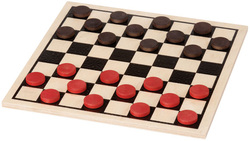
The deficit directly being addressed in this activity is balance, visual perception, and some fine motor skills.
This activity will be set up a little differently then a normal game of checkers. There will be two boards on tables about 15 feet across from one another. Connecting the two will be a walk way made from two strips of tape. To begin the activity the tape will be about 12-15 inches apart from each other. The child will start at one board; make a move working on fine motor and visual perception skills because of the checker being the same color at the board square they are playing on. Then they will turn around working on balance and walk (with ambulatory assistive devices if needed) inside the walkway formed by the tape to the other board. They will then make another move on that board, turn around and walk back. The partner playing with them will then make their first move on board one. They then continue this until someone has won the game!
This activity will address perception, motor, and praxis skills. The child will improve balance by working on controlling their body movements and staying inside the walkway. The child will also improve depth perception when looking at the checkers board and focusing on their checker piece and picking it up. They will also be working on fine motor with their fingers when picking up each playing piece.
With this activity set up in this manor there some places that allow for grading. The walk way can be graded down in size to make it more challenging for the child to stay in control and in between the two pieces of tape. The checkers can also be grades as well. Starting off with game pieces that are a totally different color than black or red will help the child visually see the difference and make it easier to process. Once the child can do that task having them play with the red and black pieces on the same color squares will make it much harder for them to depict what square has a checker on it and how to more it to another spot.
("Cerebral palsy: Hope," 2009)
This activity will be set up a little differently then a normal game of checkers. There will be two boards on tables about 15 feet across from one another. Connecting the two will be a walk way made from two strips of tape. To begin the activity the tape will be about 12-15 inches apart from each other. The child will start at one board; make a move working on fine motor and visual perception skills because of the checker being the same color at the board square they are playing on. Then they will turn around working on balance and walk (with ambulatory assistive devices if needed) inside the walkway formed by the tape to the other board. They will then make another move on that board, turn around and walk back. The partner playing with them will then make their first move on board one. They then continue this until someone has won the game!
This activity will address perception, motor, and praxis skills. The child will improve balance by working on controlling their body movements and staying inside the walkway. The child will also improve depth perception when looking at the checkers board and focusing on their checker piece and picking it up. They will also be working on fine motor with their fingers when picking up each playing piece.
With this activity set up in this manor there some places that allow for grading. The walk way can be graded down in size to make it more challenging for the child to stay in control and in between the two pieces of tape. The checkers can also be grades as well. Starting off with game pieces that are a totally different color than black or red will help the child visually see the difference and make it easier to process. Once the child can do that task having them play with the red and black pieces on the same color squares will make it much harder for them to depict what square has a checker on it and how to more it to another spot.
("Cerebral palsy: Hope," 2009)
Hitting a target
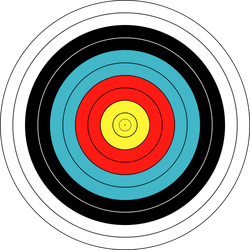
The deficit that this task addresses is hand eye coordination, balance, and grasp and release of the child’s grip.
With this activity motor, praxis, sensory functions, and hand eye coordination will be addressed. The child will improve their hand eye coordination by focusing on the target and trying to hit it. The child will also be improving on motor and praxis movements when tossing the ball at the target all while trying to maintain balance with weight shifting.
There will be a target set up about 10 feet away from the child. The child will be standing. The child will toss the ball in the direction of the target trying to get a bulls eye. Once they toss the ball they then have to go bend over and pick up the ball and return to the starting position.
This activity can be graded in a few different ways. The size of the ball can be graded starting with a bigger size and then worked down to a smaller ball to increase the amount of grasp and release needed to toss the ball. Another way this activity can be graded is by the way the child tosses the ball. They can first start with tossing it underhand. Once they have mastered that they can then be asked to toss it over hand increasing the amount of balance needed to maintain in an upright position. The distance of how far the child is from the target can also be modified. The greater the distance the more force and muscle strength is needed thus improving the child’s strength and balance.
With this activity motor, praxis, sensory functions, and hand eye coordination will be addressed. The child will improve their hand eye coordination by focusing on the target and trying to hit it. The child will also be improving on motor and praxis movements when tossing the ball at the target all while trying to maintain balance with weight shifting.
There will be a target set up about 10 feet away from the child. The child will be standing. The child will toss the ball in the direction of the target trying to get a bulls eye. Once they toss the ball they then have to go bend over and pick up the ball and return to the starting position.
This activity can be graded in a few different ways. The size of the ball can be graded starting with a bigger size and then worked down to a smaller ball to increase the amount of grasp and release needed to toss the ball. Another way this activity can be graded is by the way the child tosses the ball. They can first start with tossing it underhand. Once they have mastered that they can then be asked to toss it over hand increasing the amount of balance needed to maintain in an upright position. The distance of how far the child is from the target can also be modified. The greater the distance the more force and muscle strength is needed thus improving the child’s strength and balance.
Donning and Doffing a button shirt
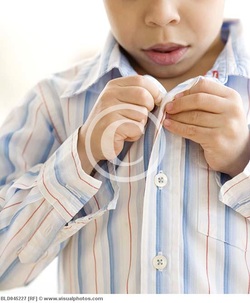
The deficit that is being addressed in this activity is fine motor coordination. Along with fine motor trunk balance and stability will also be worked on.
The goal for this activity will be to increase the fine motor and trunk stability allowing the child to independently don and doff a button shirt.
This activity will be teaching and improving the ability for the child donning and doffing their button over shirt. They will first start with sitting in a chair or on a bed. Then they will pick of the shirt and put one arm in followed by the second. Once the shirt is on they will then work on buttoning the shirt. Working on trying to work with their intention tremors they will start with the lowest button on the shirt and work up to the next buttons. Once they have it on they can then start unbuttoning them to doff the shirt.
This activity can be graded in a few ways. One way is increasing the number of times the child is asked to don and doff the buttons of the shirt. Another way is once the child has enough trunk stability to have them do this activity while standing to increase the difficulty.
(Brody, 2005)
The goal for this activity will be to increase the fine motor and trunk stability allowing the child to independently don and doff a button shirt.
This activity will be teaching and improving the ability for the child donning and doffing their button over shirt. They will first start with sitting in a chair or on a bed. Then they will pick of the shirt and put one arm in followed by the second. Once the shirt is on they will then work on buttoning the shirt. Working on trying to work with their intention tremors they will start with the lowest button on the shirt and work up to the next buttons. Once they have it on they can then start unbuttoning them to doff the shirt.
This activity can be graded in a few ways. One way is increasing the number of times the child is asked to don and doff the buttons of the shirt. Another way is once the child has enough trunk stability to have them do this activity while standing to increase the difficulty.
(Brody, 2005)
Catching a Ball
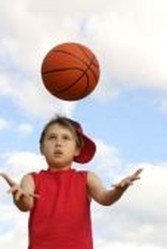
This activity will be working on improving the child’s depth perception.
The goal for this activity is to improve the child’s depth perception allowing them to better interpret their environment and have improved safety in their mobility.
For this activity the person playing with the child will stand/sit (depending on the child’s stability) about 6 feet apart from the child. The helper will toss the ball towards the child just high enough to reach their chest. The child will then catch the ball, re-grip, and toss the ball back to the person playing with them trying to use their chest as a target area as well.
This activity can be graded in a few ways. One way it can be graded is by increasing the distance between the two people playing. With the greater distance the child will have to interpret the changing visual input. Another way it can be graded is by the size of the ball. Once the child shows they are proficient in catching a larger ball downsizing the ball will increase the difficulty.
The goal for this activity is to improve the child’s depth perception allowing them to better interpret their environment and have improved safety in their mobility.
For this activity the person playing with the child will stand/sit (depending on the child’s stability) about 6 feet apart from the child. The helper will toss the ball towards the child just high enough to reach their chest. The child will then catch the ball, re-grip, and toss the ball back to the person playing with them trying to use their chest as a target area as well.
This activity can be graded in a few ways. One way it can be graded is by increasing the distance between the two people playing. With the greater distance the child will have to interpret the changing visual input. Another way it can be graded is by the size of the ball. Once the child shows they are proficient in catching a larger ball downsizing the ball will increase the difficulty.
Puzzle
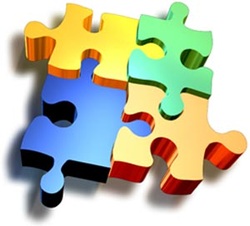
This activity is working on fine motor skills.
The goal for this activity is to improve fine motor skills to allow for more efficient use of their fingers and hands in activities of daily living such as feeding themselves and brushing teeth.
The child will be putting a 25-50 piece puzzle together. They will have to flip over all the pieces so that the picture side is showing and then start putting them together. Once the puzzle is complete the child will then have to pick up all the pieces and put them back in the box.
This activity can be graded by the number of puzzle pieces in the puzzle. The more puzzle pieces the longer it will take the child to do the task increasing the endurance of their fingers and fine motor control. Another way to grade the activity is by using smaller puzzle pieces. With the smaller puzzle piece it will be harder for the child to grasp and then rotate and place the piece in the correct position.
The goal for this activity is to improve fine motor skills to allow for more efficient use of their fingers and hands in activities of daily living such as feeding themselves and brushing teeth.
The child will be putting a 25-50 piece puzzle together. They will have to flip over all the pieces so that the picture side is showing and then start putting them together. Once the puzzle is complete the child will then have to pick up all the pieces and put them back in the box.
This activity can be graded by the number of puzzle pieces in the puzzle. The more puzzle pieces the longer it will take the child to do the task increasing the endurance of their fingers and fine motor control. Another way to grade the activity is by using smaller puzzle pieces. With the smaller puzzle piece it will be harder for the child to grasp and then rotate and place the piece in the correct position.
